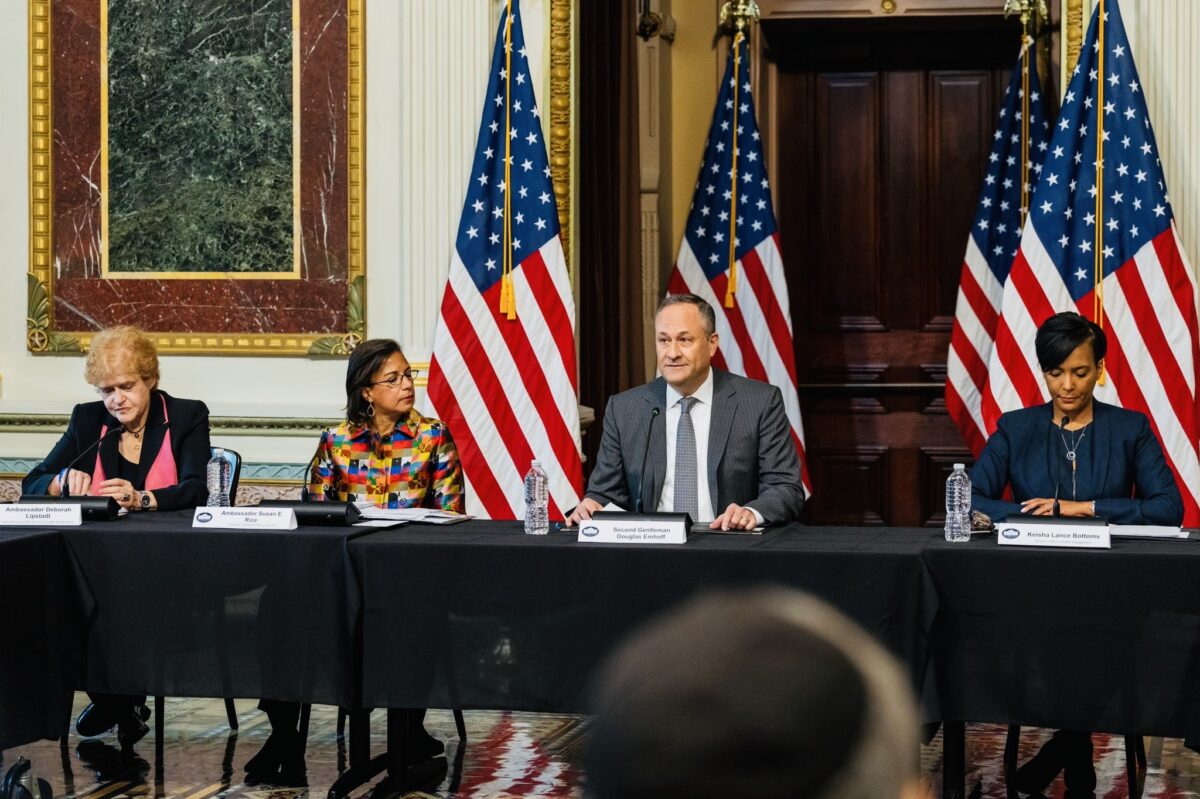The United States has been a safe haven for Jews since its inception as a nation more than two hundred years ago. And since World War II, American Jews have made tremendous strides in breaking down discriminatory barriers that once were taken for granted with a shrug of the shoulders.
But of late, in the face of a rising tide of openly-expressed antisemitism in the United States, Jews have begun to wonder about its capacity to combat tangible manifestations of hated.
Recognizing the severity of the problem, the White House on December 7 invited top Biden administration officials and representatives from a panoply of Jewish organizations, from the American Jewish Committee to American Friends of Lubavitch, to attend a roundtable discussion on antisemitism chaired by Doug Emhoff, the husband of U.S. Vice-President Kamala Harris.
Describing the wave of antisemitism as an “epidemic of hate,” Emhoff — the grandson of Polish Jewish immigrants — said, “Let me be clear — words matter. People are no longer saying the quiet parts out loud, they are screaming them. We cannot normalize this. We all have an obligation to condemn these vile acts. We must not stay silent. There are no two sides. Everyone must be against this.”
A day before this meeting, 125 lawmakers from the House of Representatives and the Senate urged the Biden administration to adopt a plan of action to deal with the uptick of antisemitism.
Last year, antisemitic incidents reached a record high, with 2,717 incidents of assault, harassment and vandalism having been tabulated by the Anti-Defamation League. This was a 34 percent increase over the previous year, and the highest number since the ADL began tracking such incidents in 1979.
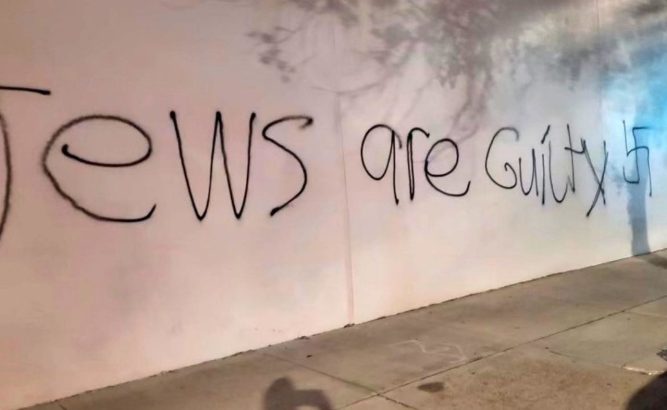
In the past few months, still more evidence has emerged that antisemitism in the U.S. is in the process of being normalized.
The rapper Kanye West, with 32 million followers on social media, threatened to go “death con 3” on Jews and delivered a series of other antisemitic comments that might have been unthinkable a decade ago.
The basketball star Kyrie Irving promoted an antisemitic film on social media.
The former U.S. president, Donald Trump, hosted West and his friend, the antisemitic propagandist and Holocaust denier Nick Fuentes, at his Mar-A-Lago estate in Florida. (Trump has condemned neither West nor Fuentes, but on December 9, he blasted Jewish leaders for not being sufficiently loyal to him after his pro-Israel moves as president).
There has been a dramatic upsurge of anti-Jewish hate speech and disinformation on Twitter since it was purchased by Elon Musk, who has called himself a “free speech absolutist.”
Last month, a man from New Jersey was arrested after publishing an online manifesto calling for attacks on synagogues, and another man was detained after tweeting about his plan to “shoot up a synagogue and die.”
Ultra-Orthodox Jews have been repeatedly assaulted in New York City, home to the largest concentration of Jews in the country.
In short, antisemitism has moved from the margins to the center of society.
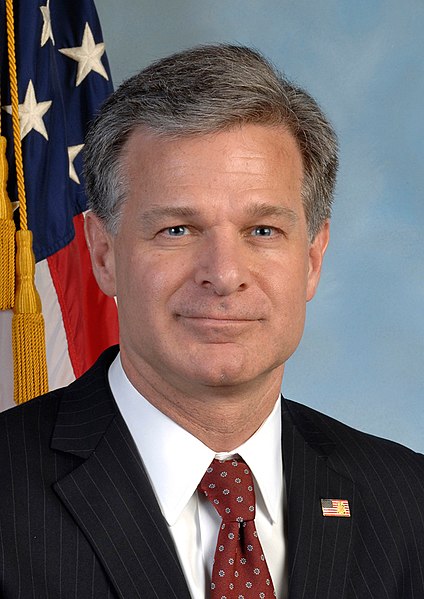
The deluge of attacks prompted Christopher Wray, the director of the Federal Bureau of Investigation, or FBI, to say recently that Jews, representing about 2.4 percent of the U.S. population, are “getting hit from all sides.”
Responding to a question from U.S. Congressman Josh Gottheimer, Wray said that antisemitism is a “persistent and present fact” in contemporary America. “It’s a community that deserves and desperately needs out support because it’s getting hit from all sides,” he added.
He went to to say that the FBI is addressing the issue by raising the threat of antisemitism to a “national priority.”
Last year, the Biden administration unveiled a national strategy to combat domestic extremism. “We cannot ignore this threat or wish it away,” President Joe Biden said.
“We cannot promise that we will be able to disrupt every plot, defuse every bomb or arrest every co-conspirator before they manage to wreak unspeakable horror, but we can promise that we will do everything in our power to prevent such tragedies,” Attorney General Merrick Garland said after explaining the new policy.
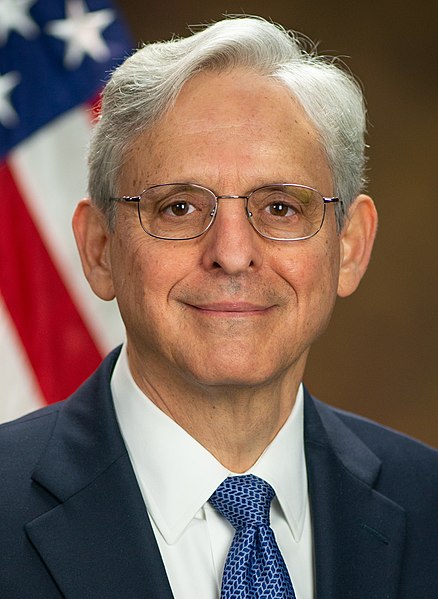
It consist of improving information sharing among law enforcement agencies, preventing recruitment by extremist groups, and confronting the causes of domestic terrorism: racism and bigotry.
Public antisemitism reared its ugly head in 2017 when racists converged on Charlottesville, Virginia, for a Unite the Right rally. During the course of this event, hundreds of them, in a chilling night-time march, chanted, “Jews will not replace us.”
Anti-Jewish violence in the U.S. took a sharp turn for the worse in 2018, when Robert Bowers, a neo-Nazi, killed 11 Jewish worshippers at the Tree of Life Synagogue in Pittsburgh, in the deadliest antisemitic incident in American history.
Shortly afterward, John Earnest, a white supremacist, fatally shot a Jewish woman at a synagogue in Poway, California.

In 2019, African American two attackers opened fire in a kosher supermarket in Jersey City, killing the Jewish owner, a Jewish customer and a store employee. In the same year, Grafton Thomas, an African American, shot and wounded a rabbi in Monsey, New York, a bastion of haredi Jews. A few months later, he succumbed to his wounds
Alvin Rosenfeld, a professor of Jewish studies at the University of Indiana, has studied this phenomenon of hate and placed it in its historic context. In a recent piece in Fathom magazine, he wrote:
“America has never been altogether free of antisemitism, but most American Jews have not had to contend with ongoing hostility of a seriously threatening kind. Social prejudice of an antisemitic nature has long been a fact of American life, and there have been instances of episodic violence directed against Jews, synagogues, Jewish schools, and other communal institutions.
“Compared to the experiences of Jews in Europe, the Middle East, and North Africa, though, most American Jews have not lived with serious concerns about chronic persecution and lethal attacks. Especially in the decades following World War II, they have felt largely safe and at home in America.
“This sense of security and relative normality can no longer be taken for granted. Hostility to Jews, in both word and deed, is now a growing presence within the public sphere and has been moving from the fringes, where it has long existed, into the mainstream. Pittsburgh, Poway, Jersey City, and Monsey are the sites of recent and particularly deadly attacks, but in less dramatic and often under-reported ways, assaults against Jews in New York City, Chicago, Los Angeles, Miami, and elsewhere have become commonplace.
“According to recent surveys, in fact, the numbers of attacks against American Jews and Jewish institutions appear to be increasing year by year. No one can say for sure just how bad such hostility may become, but downplaying the destructive potential of Jew-hatred is always a mistake.”
Lest it be forgotten, American Jews, though physically secure and equal under the law, were often regarded as outsiders by ethnocentric Americans and subjected to blatant discrimination in employment, housing and university admission. And in the spirit of the times, Jews were regularly excluded from membership in country clubs.
Henry Ford, a preeminent industrialist, printed excerpts of the Protocols of the Elders of Zion in his newspaper in Dearborn, Michigan.
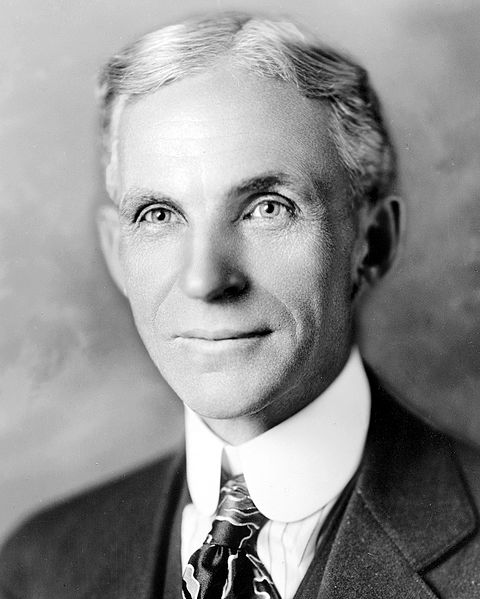
In the early 1920s, the U.S. Congress passed a restrictive immigration bill aimed, in part, at Jewish immigrants.
Charles Lindbergh, an American hero, disseminated antisemitic myths and tropes on the eve of the United States’ entry into World War II.
During the 1930s and 1940s, the Ku Klux Klan, the Silver Shirts and the German American Bund railed against Jews. And from the 1950s onward, the American Nazi Party and Aryan Nations, among others, demonized Jews.
Lately, antisemitism has crept into the rhetoric of some progressive champions of the Palestinian cause.
So, as Wray suggested recently, Jews are “getting hit from all sides.”
Historically, explicit antisemitism, particularly its violent variety, has been cyclical in nature, waxing and waning. So it remains to be seen whether the current outbreak will be of short duration or last considerably longer.
But for now, Jewish Americans have reason to be concerned by the climate of intolerance that is currently gripping the United States.
